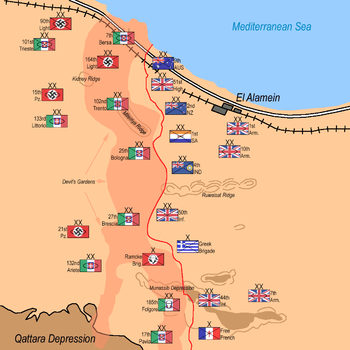Devil's gardens

The Devil's gardens was the name given by Erwin Rommel,[1] commander of the German Afrika Korps during World War II, to the defensive entanglements of land mines and barbed wire protecting his positions during the Second Battle of El Alamein in late 1942. The defences stretch from the Mediterranean coast to the Qattara Depression.

During the 'break-in' phase of the battle, British commander Lieutenant General Bernard Montgomery planned for engineer troops supporting infantry brigades of 2nd New Zealand Division to clear lanes through the minefields along which attacking formations would pass into the Axis positions. Engineers using hand tools were supplemented by Scorpion tanks equipped with rotating flails to explode anti-vehicle mines. These did not work well and manual methods of clearing had to be employed. This would have been more difficult, had the minefields not been sown with relatively few anti-personnel mines.[2]
An estimated 3 million mines were laid before the battle, most of which remain in position to this day, becoming more unstable as the years pass and injuring local people who use the area.[1][3]
References
- 1 2 "Sixty years on and the El Alamein armaments still maim". The Daily Telegraph. 19 October 2002. Retrieved 29 August 2011.
- ↑ Schneck, William. Breaching the Devil's Garden: The 6th New Zealand Brigade in Operation Lightfoot. The Second Battle of El Alamein. 2005. US Army Communications-Electronics Command
- ↑ "Lethal landmine legacy from battle of El Alamein". BBC News. 20 March 2010.